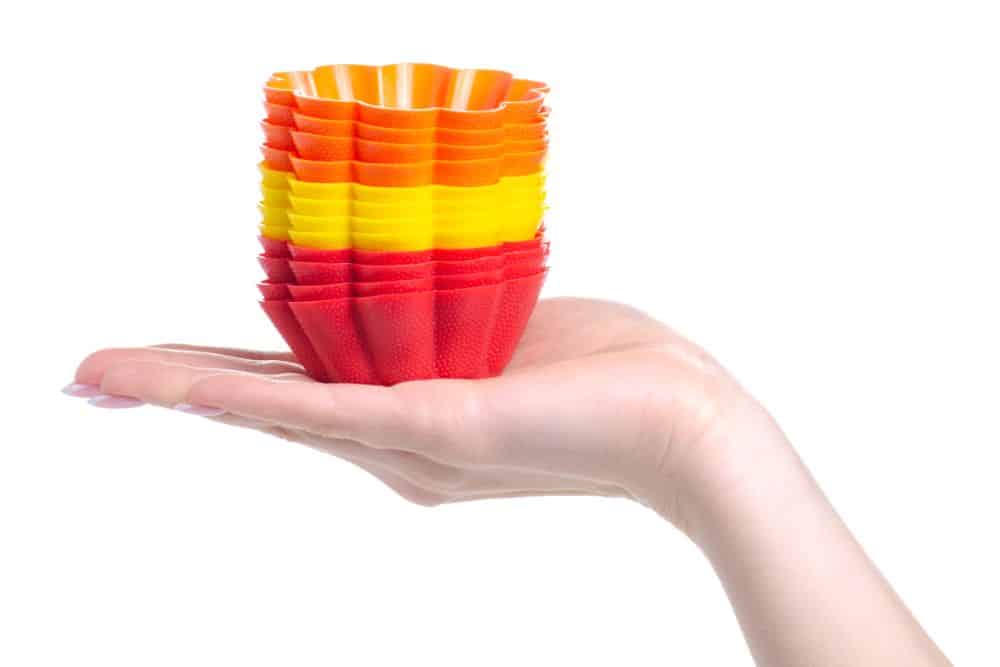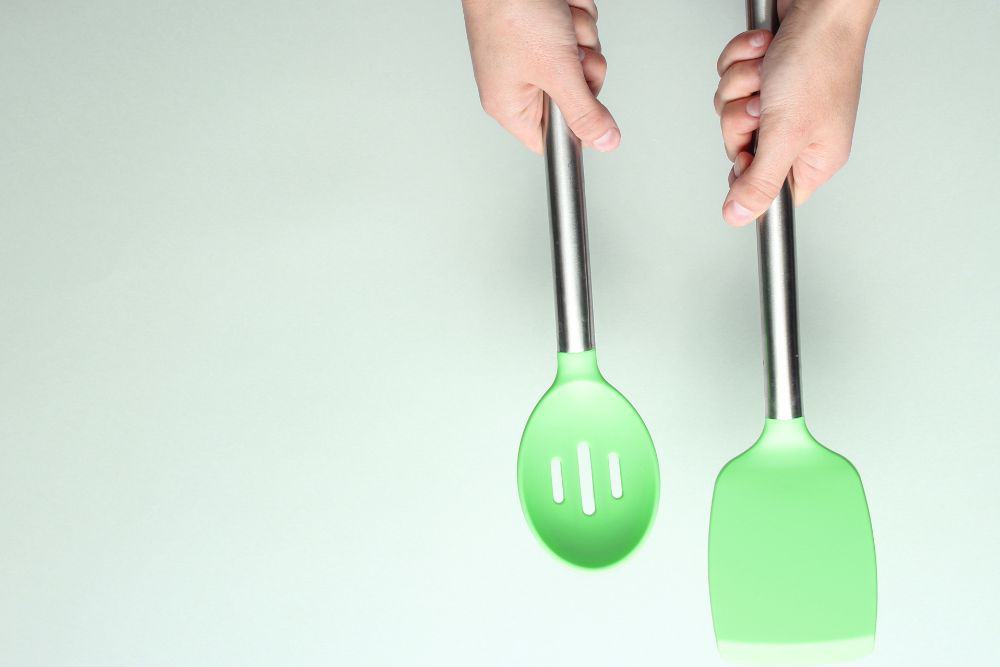Anyone who walks by the home goods section of a supermarket knows there are plenty of kitchenware items to check out. As more folks turn to home cooking for their meals, some folks want to know why there are so many different materials to make kitchenware out of, such as silicone.
Silicone stands out compared to metal or plastic because of its association with non-food items. Plus. doesn’t silicone melt at high temperatures as we see in electronics? It turns out that while some forms of silicone do melt in the oven, food grade silicone is different.
The silicone used in kitchenware comes from a combination of elemental silicon and synthetic rubber. The addition of silicon to rubber allows the rubber to keep some of the stuff we like about rubber, like its pliability, while also rendering the rubber inert. Inert materials don’t react or bond to other chemicals, meaning silicone won’t dissolve into or fuse with things like food.

Silicone Ramekins for Cupcakes
The idea of silicone goes back to the early 1900s when people began to notice that the element silicon didn’t react with other stuff the same way, especially when it forms a long chain shape that folds in on itself. Since then, silicone can be found in sealants, electronics, and other applications that require an inert material, including cooking.
Food-grade silicone is used in one of two applications to assist chefs when they cook. The first application involves a lubricated silicone piece of kitchenware designed to be non-toxic and chemically stable. The second application refers to custom molds that allow the chef or baker to create custom shapes for their food when cooked or baked.
In either case, food-grade silicone gest its name from the fact that it is safe to use while cooking.
For most home use, silicone won’t melt in your oven. The melting point for silicone is around 500 degrees Fahrenheit, or 260 degrees Celsius. Since most baking recipes call for a temperature below 425 degrees Fahrenheit or 220 degrees Celsius, you won’t have to worry about your silicone bakeware fusing with your food.

A Silicone Oven Mitt Holds Up Well at High Temperatures
However, you will need to watch out for your silicone softening at these temperatures. Even though it won’t melt at these temperatures, silicone becomes more flexible as it heats up, meaning it won’t have the same structure to it at oven temperature as it will at room temperature.
OXO Silicone Oven Mitts Can Withstand High Temperatures
This won’t matter for folks that use a silicone baking mold on a metal cookie tray. However, it does mean that you’ll need to be careful if you don’t have anything metal or ceramic to give your silicone structure while in the oven. (Note: Metal is generally safe in the oven, but be sure to follow manufacturer's guidelines). Pliable silicone left on the hot oven rack could lilt or lean, causing your food to leak inside the oven.
Many folks associate silicone with things other than cooking. Cosmetic implants, electronics, and other industrial sectors use silicone to make things that don’t belong in your stomach. So, is silicone safe to use as cookware given all its other applications?
There are two things to remember about food-grade silicone. The first is that it’s a mixture of silicone and rubber. The silicone mixes with the rubber to prevent the resin in the rubber from bounding to anything else by taking up the spots things like food would bind to.
The second thing is that high-quality silicone kitchenware goes through treatment to seal it. This treatment mainly involves curing the silicone at high heat to finish any reactions the silicone tries to go through after being made and allows gases trapped from mixing to escape slowly.
Part of the concern about silicone also stems from the misappropriation of concerns regarding plastic to silicone. Plastics like BPA, which we know are bad for the body, are a different category of material than silicone and go through different manufacturing practices to make. There’s never a point where plastics like BPA go into silicone, meaning silicone is BPA-free.
Toxicity concerns aside, silicone is safe for most places in the kitchen. When sealed properly, silicone kitchenware is good in the oven, microwave, refrigerator, and even the freezer. The rubber component of the silicone doesn’t begin to lose its structure until the upper end of the silicone’s operating temperature, so feel free to use it anywhere there isn’t an open flame.
So, with some of the info laid out about silicone kitchenware, the question is: are silicone utensils worth it? After all, silicone seems like an overall safe material to use.
Well, there are some positives to using silicone cookware, such as:
Basically, silicone cookware offers some convenience and eco-friendly benefits compared to other kitchenware materials. Silicone molds and cake pans are there to make baking and cleanup easier.
However, silicone is not the end-all, be-all of kitchenware. Plenty of home cooks and professional chefs alike are leery about silicone tools, mostly for these reasons:
So, while silicone kitchenware makes things easier around the kitchen, you can’t use the tools like the ceramic or metal tools you have already.
Whether you have silicone utensils already or want to get some for yourself, there are some things to think about first. Here are some tidbits we wanted to pass along your way:
The most common silicone bakeware items are cake pans, silicone baking mats, and molds. All of these products give you something easy to clean while also staying reusable.
When you first get one of these items, don’t hesitate to run it through the dishwasher first. Sometimes, silicone items have residue from manufacturing left on them when packaged. This residue contains all sorts of industrial-grade chemicals that you don’t want in your body. Adding your new silicone item to your dishes for a cycle can clear out most of that residue.
However, don’t forget to use butter or oil of some kind when using these utensils! Silicone receives a lubrication treatment as part of its coating, but that lubrication doesn’t exist by the time you get the item. So, if you don’t want your dessert to stick to your bakeware, use some butter or grease as if it were a metal item.
For the most part, silicone cookware is easy to clean. Dish soap and water, plus a little elbow grease, usually does the job with these items.

A Silicone Spatula and Slotted Spoon
Also, while it might be tempting to toss these items into the dishwasher, it’s usually better to hand-wash them. Silicone bakeware can survive a rinse cycle in the dishwasher, but they don’t require this deep cleaning after every use. Doing so just speeds up how quickly the silicone degrades.
Plus, remember that the silicone receives treatment during manufacturing. Part of the point of this treatment is to seal the silicone from outside materials, including the food you cook. You shouldn’t be seeing bits of food mixing into your silicone items.
If you do, that’s a clear sign that the silicone is damaged and should be replaced. Those tears in the silicone can get bigger over time. The last thing you want to see when you pull your food out of the oven is your silicone mat tear into two.
Here are the answers to some of the common questions out there about silicone rubber kitchenware.
Yes, you can bake with silicone. Silicone stays heat resistant up to around 440 degrees Fahrenheit or 227 degrees Celsius. So, as long as your recipe doesn’t call for extreme temperatures, you can use a silicone baking mat or other silicone pans in your oven safely.
As long as the temperature of the oven isn’t too high, you can use a silicone mold inside of the oven.
Silicone molds work well with other kitchen appliances, too. Silicone molds are not just oven-safe, but also safe in the refrigerator, freezer, and microwave.
The silicone melting point is right around 500 degrees Fahrenheit, which is about 260 degrees Celsius. This high melting point means that something like a silicone mat works well protect your countertop from a hot air fryer and ora silicone pan works for all but extremely high temperature recipe requirements.
Note that silicone bakeware and related products aren’t nearly as great a conductor of heat as metal, which results in silicone baking pans not browning food as well as a traditional metal cookie sheet or other metal bakeware.
